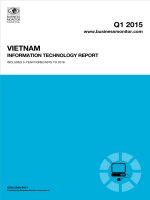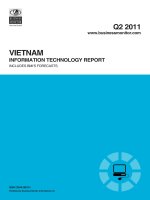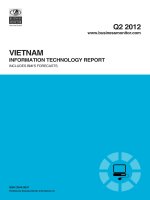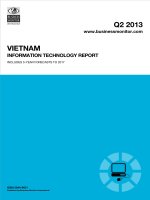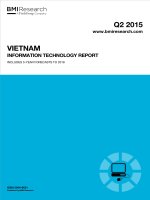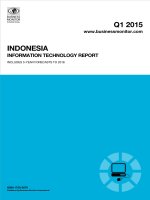Australia information technology report q2 2015
Bạn đang xem bản rút gọn của tài liệu. Xem và tải ngay bản đầy đủ của tài liệu tại đây (451.85 KB, 96 trang )
Q2 2015
www.bmiresearch.com
AUSTRALIA
INFORMATION TECHNOLOGY REPORT
INCLUDES 5-YEAR FORECASTS TO 2019
ISSN 2041-7160
Published by:BMI Research
Australia Information Technology Report
Q2 2015
INCLUDES 5-YEAR FORECASTS TO 2019
Part of BMI’s Industry Report & Forecasts Series
Published by: BMI Research
Copy deadline: March 2015
BMI Research
Senator House
85 Queen Victoria Street
London
EC4V 4AB
United Kingdom
Tel: +44 (0) 20 7248 0468
Fax: +44 (0) 20 7248 0467
Email:
Web:
© 2015 Business Monitor International Ltd
All rights reserved.
All information contained in this publication is
copyrighted in the name of Business Monitor
International Ltd, and as such no part of this
publication may be reproduced, repackaged,
redistributed, resold in whole or in any part, or used
in any form or by any means graphic, electronic or
mechanical, including photocopying, recording,
taping, or by information storage or retrieval, or by
any other means, without the express written consent
of the publisher.
DISCLAIMER
All information contained in this publication has been researched and compiled from sources believed to be accurate and reliable at the time of
publishing. However, in view of the natural scope for human and/or mechanical error, either at source or during production, Business Monitor
International Ltd accepts no liability whatsoever for any loss or damage resulting from errors, inaccuracies or omissions affecting any part of the
publication. All information is provided without warranty, and Business Monitor International Ltd makes no representation of warranty of any kind
as to the accuracy or completeness of any information hereto contained.
CONTENTS
BMI Industry View 7
SWOT 9
IT SWOT 9
Wireline SWOT 11
Political 13
Economic 14
Operational Risk 15
Industry Forecast 17
Table: IT Industry - Historical Data And Forecasts (Australia 2012-2019) 17
2015 Outlook 17
Macroeconomic Forecasts 23
Economic Analysis 23
Table: Economic Activity (Australia 2010-2019) 28
Industry Risk Reward Ratings 29
Industry Risk Reward Index 29
Table: Asia Pacific Risk/Reward Index - Q2 2015 31
Market Overview 32
Hardware 32
Software 40
Services 44
Industry Trends And Developments 52
Regulatory Development 58
Table: Government Authority 58
Government Initiatives 58
Regulatory News 60
Competitive Landscape 63
International Companies 63
Table: Dell 63
Table: Datacom 64
Table: SAP 65
Table: Panasonic 66
Local Company 66
Table: The Good Guys 66
Company Profile 67
Australia Information Technology Report Q2 2015
© Business Monitor International Ltd Page 4
SAP 67
Hewlett-Packard 73
Table: Hewlett-Packard Financial Performance By Division 78
Regional Overview 82
Demographic Forecast 86
Table: Population Headline Indicators (Australia 1990-2025) 87
Table: Key Population Ratios (Australia 1990-2025) 87
Table: Urban/Rural Population & Life Expectancy (Australia 1990-2025) 88
Table: Population By Age Group (Australia 1990-2025) 88
Table: Population By Age Group % (Australia 1990-2025) 89
Methodology 91
Industry Forecast Methodology 91
Sources 92
Risk/Reward Index Methodology 93
Table: It Risk/Reward Index Indicators 94
Table: Weighting Of Components 95
Australia Information Technology Report Q2 2015
© Business Monitor International Ltd Page 5
BMI Industry View
BMI View: Due to high labour costs, BMI believes Australian enterprises could be among the early
adopters for AI applications such as IBM's Ask Watson service, which has already been trialled by ANZ
Bank. Emerging technologies aside, the growth outlook is relatively weak in Australia. This is in part a
consequence of market maturity, meaning growth will underperform the APAC average, which is weighted
to emerging markets, but there is also macroeconomic downside as BMI expects economic growth to slow
over the medium term.
Headline Expenditure Projections
■
Computer Hardware Sales: AUD8.2bn in 2014 to AUD8.5bn in 2015, up 3.8% in local currency terms.
Slowdown in tablet demand due to market saturation will be offset by a stabilisation in desktop and
notebook sales in 2015 due to design innovation in the hybrid notebook market.
■
Software Sales: AUD4.7bn in 2014 to AUD4.8bn in 2015, up 0.8% in local currency terms. Security
software will outperform, particularly for small and medium-sized enterprises (SMEs) and consumers -
but the effect of XP enterprise upgrades will be diminished.
■
IT Services Sales: AUD9.7bn in 2014 to AUD10.7bn in 2015, up 9.6% in local currency terms. IT
services will be fastest growth area of the IT market over the medium term, with cloud services the key
growth driver as local companies try to use efficiencies enabled by the National Broadband Network
(NBN).
Australia Information Technology Report Q2 2015
© Business Monitor International Ltd Page 7
Key Trends And Developments
After a sustained boom since 2012, the Australian tablet market appears to have peaked, in line with BMI's
expectations. High-street consumer electronics retailer JB Hi-Fi reported that sales in July 2014 fell by
5.5% year-on-year, mainly due to a significant slump in demand for new and replacement tablet computers.
We believe this data reflects the level of consumer satisfaction with existing products and the slower rate of
innovation by leading vendors such as Apple and Samsung that have produced iterative improvements
rather than significant changes in recent announcements. Although a small uptick is expected in 2016 as
mobile network operators seek to attract customers to their new 4G mobile broadband networks by
including tablets in new service bundles, sales are expected to fall in the following years as the operational
lives of high-spec devices - as well as their high cost - obviates the need to buy a replacement in the short to
medium term.
In contrast to the slowdown in tablet demand the Australian cloud computing growth story has plenty of
momentum remaining. The latest research by the Australian Communications and Media Authority
(ACMA) showed the adoption of cloud computing services continued in 2013. In March 2014 the ACMA
claimed that 36% of SMEs actively using cloud services believed that such services provided easier or more
convenient access to data and key resources (36%), assisted in making key productivity tools accessible
from multiple locations (15%) and that disaster recovery would be facilitated through the use of cloud-based
platforms (11%).
Australia Information Technology Report Q2 2015
© Business Monitor International Ltd Page 8
SWOT
IT SWOT
SWOT Analysis
Strengths
■
High incomes and strong supporting infrastructure drive high levels of IT spending per
capita.
■
Strong government support for ICT programmes.
■
IT-literate population with high levels of PC ownership and a propensity for premium
devices.
■
Strong financial sector, a large source of demand for enterprise software and
services.
■
Tablet boom has offset the decline in desktop and notebook sales.
Weaknesses
■
Australia has a relatively mature domestic market, with correspondingly slow growth
rates.
■
Sensitive to volatility in the global economy.
Opportunities
■
High labour costs and proximity of low-cost competition make Australia a fertile
market for automation technologies such as IBM's Watson and other personal
assistant products.
■
Considerable demand for cloud computing services from both the public and
enterprise sector.
■
Government cloud computing strategy creates opportunities for vendors in the public
and SME sectors.
■
Potential for a rebound in notebook sales as hybrid designs evolve.
■
Other major IT projects in areas such as healthcare, education and smart cards.
Australia Information Technology Report Q2 2015
© Business Monitor International Ltd Page 9
SWOT Analysis - Continued
Threats
■
A cheaper Australian dollar would affect consumer and business demand in the
import-dependent IT market, with downside weighted towards the latter years of our
forecast.
■
Vendors face threat of parliamentary enquiry into product pricing and are coming
under pressure regarding tax arrangements.
■
Data from retailers indicate a sharp slowdown in the tablet market in 2014, in line with
our long-held view that saturation and slower rate of innovation would result in longer
replacement cycles.
Australia Information Technology Report Q2 2015
© Business Monitor International Ltd Page 10
Wireline SWOT
Australia Wireline SWOT
Strengths
■
Australia's overall wireline sector is host to a large number of service providers, many
of which offer a full range of voice, data and internet services.
■
Many service providers offer broadband internet connectivity by means of several
different technologies.
■
The penetration rate, measured as a proportion of buildings reached with broadband
network infrastructure, is extremely high.
■
The residential market supports strong demand for pay-TV services.
■
The business market supports strong demand for converged data services.
■
Australia's leading broadband operators continue to report strong internet and
multimedia service sales.
Weaknesses
■
Despite a significant number of service providers, the broadband market continues to
be dominated by Telstra.
■
Despite fixed-line market liberalisation and steady growth in the number of unbundled
local loops, Telstra remains the dominant player in the sector.
■
After a period of moderate growth, business demand for fixed telephony lines now
appears to be weakening.
■
Overall, demand for traditional fixed-line services is shrinking, resulting in a
diminishing market.
Opportunities
■
The National Broadband Network, announced in April 2013, aims to be completed
sooner and more cheaply, with the trade-off being slower connectivity.
■
Demand for wireless broadband services, including WiMAX, 3G datacard and USB
modem-supported services is growing.
Australia Information Technology Report Q2 2015
© Business Monitor International Ltd Page 11
Australia Wireline SWOT - Continued
■
Australia's leading broadband operators are investing in the development of higher
speed broadband services. This has potential to drive demand for new data services.
■
The government revealed that it has set aside AUD60mn for regional, rural and
remote telecoms projects; satellite and wireless broadband networks are seen as a
source of potential investment in remote regions.
Threats
■
Fixed-line sector may decline at a more rapid rate than expected, with potentially
negative consequences for ADSL growth.
■
Proliferation of naked ADSL could hasten the decline of the fixed-line sector.
■
Growing popularity of wireless broadband services could negatively affect the market
for fixed broadband access based on DSL and cable.
■
The high rate of broadband penetration reduces the scope for further growth in the
broadband sector; growth will slow as the market nears saturation point.
■
Following the election of the new Liberal-National Coalition government in September
2013, the NBN is likely to offer slower connectivity than originally envisaged.
Australia Information Technology Report Q2 2015
© Business Monitor International Ltd Page 12
Political
SWOT Analysis
Strengths
■
Australia is a mature democracy with a broadly stable party system.
■
Economic stability over recent years supports the current political system and radical
groups are unlikely to gain substantial support.
Weaknesses
■
As one of the region's largest and most stable states, the country attracts many
refugees and economic migrants. The issue is a key source of domestic tension and
has been hotly debated in parliament in recent times as the capsizing of a boat led to
the death of a number of refugees. The issue continues to be debated in the federal
parliament with no sign that political parties will find a viable alternative that would
ensure the safe passage and fair processing of the refugees, while reducing the
possibility of people smuggling.
■
The fragility of the state governments' finances compared to the large infrastructure
projects that they need to undertake has led to questions with regards to the
compatibility of the federal-state system with the country's current development
needs.
Opportunities
■
Australia has historically enjoyed close military ties with the US. However, with the
rise of regional economic powers such as China, it will need to balance competing
military and economic ties.
Threats
■
Australia's early support for the US 'War on Terror', among other things, has made
Australians abroad a target for Islamic extremists.
■
Australia's close alliance with the US, particularly under John Howard, has left a
lingering feeling among some Asian governments that it is America's 'deputy sheriff'
in the region.
Australia Information Technology Report Q2 2015
© Business Monitor International Ltd Page 13
Economic
SWOT Analysis
Strengths
■
A free-market economy supported by a highly educated workforce.
■
Blessed with rich natural resources, Australia's economic activity has been
augmented by demand for commodity exports and the investments made in the
mining sector.
Weaknesses
■
The persistent current account deficit increases vulnerability to capital flows and, by
extension, currency volatility.
■
The export basket is highly concentrated in commodities, and consequently exposes
the economy and currency to fluctuations in world prices for metals, coal and
agricultural goods.
Opportunities
■
The rapid expansion of Asian economies in recent years offers new opportunities for
diversifying trading ties from core European markets.
■
A low level of government debt has provided a certain amount of flexibility in fiscal
policy to support domestic demand through the downturn.
Threats
■
The high level of private sector debt - especially mortgage loans - fuelled by overseas
funding poses a threat to sustained growth and financial stability.
■
A collapse in exports from a drop in resource demand from China and other resource-
hungry countries would severely impact headline GDP growth.
■
Australia is vulnerable to extreme weather that may lead to droughts and floods,
which have become increasingly severe in past years as a result of global climate
change.
Australia Information Technology Report Q2 2015
© Business Monitor International Ltd Page 14
Operational Risk
SWOT Analysis
Strengths
■
A highly educated workforce and comparatively modern transport infrastructure
underpin economic prospects.
■
A number of free trade agreements with countries such as New Zealand, Thailand and
the US serve as a boon for trading activities.
Weaknesses
■
Despite its openness, Australia requires the Foreign Investment Review Board to
approve any commercial real estate investment by a foreign company or individual
valued at USD5mn or more.
■
With a population of just over 23mn, the domestic consumer base is small by regional
standards.
Opportunities
■
Australia is currently in talks with the Gulf Cooperation Council, India, and Indonesia
regarding bilateral free trade agreements. It is also part of PACER and RCEP talks.
■
Upgrade and expansion of urban infrastructure will be needed to sustain population
growth in Australia's main cities, providing opportunities for public-private
partnerships in the future. The government is also targeting infrastructure
improvements to rural areas.
■
More healthcare infrastructure will be needed to support the ageing population, and
with the introduction of the federal government's National Disability Insurance
Scheme, the industry is likely to see increasing demand for services.
Threats
■
Corporate taxes for foreign investors in Australia remain higher than in other
countries, and it seems unlikely that the government will succeed to reduce the rates
in the near future.
■
Recent investment proposals by Chinese firms regarding the agricultural and resource
extraction sector have raised fears that strategic assets will be lost to foreign players.
This has led to more conditions attached to the sale agreements, which is likely to
reduce the attractiveness of these assets. It remains to be seen if the recent
Australia Information Technology Report Q2 2015
© Business Monitor International Ltd Page 15
SWOT Analysis - Continued
implementation of a database to increase transparency around foreign-owned
Australian assets will spur more regulation.
Australia Information Technology Report Q2 2015
© Business Monitor International Ltd Page 16
Industry Forecast
Table: IT Industry - Historical Data And Forecasts (Australia 2012-2019)
2012 2013 2014e 2015f 2016f 2017f 2018f 2019f
IT market value, AUDmn 20,585.3 21,414.9 22,654.8 23,941.6 25,169.8 26,413.2 27,667.8 28,929.4
Computer hardware sales,
AUDmn
7,756.5 7,904.2 8,185.2 8,499.3 8,718.8 9,006.9 9,241.0 9,459.9
Personal computer sales, AUDmn 6,231.6 6,397.7 6,612.8 6,853.8 7,017.8 7,236.1 7,410.4 7,571.7
Software sales, AUDmn 4,162.3 4,345.1 4,728.1 4,764.4 5,099.4 5,272.1 5,483.8 5,693.3
Services sales, AUDmn 8,666.4 9,165.6 9,741.6 10,677.9 11,351.6 12,134.2 12,943.0 13,776.2
IT market value, % of GDP 1.4 1.4 1.4 1.4 1.4 1.4 1.4 1.4
e/f = estimate/forecast. Source: BMI
We maintain our view for solid growth in Australia's IT market in local currency terms, as we forecast a
compound annual growth rate (CAGR) of 5.3% 2014-2019, with the market reaching AUD28.93bn by the
end of our five-year forecast period in 2019. Over this period, the market will remain stable at around 1.4%
of GDP. The Australian IT market has considerable medium-term potential, particularly in areas such as
tablets, cloud computing, real-time enterprise software and data centre growth.
However, it should be noted that as a result of BMI's in-house Country Risk forecast for significant
weakening of the Australian dollar against the US dollar over the forecast period, the IT market is forecast
to grow at a CAGR of just 0.1% in US dollar terms 2014-2019.
2015 Outlook
BMI forecasts the IT market will expand by 5.7% in local currency terms in 2015, to reach a value of
AUD23.9bn.
Despite the economic environment becoming less supportive of IT market expansion, we continue to
forecast GDP and private final consumption will grow in real terms in 2015. We forecast real GDP growth
of 2.3% in 2015 (the same as for 2014), and an increase from 1.3% real growth in 2014 to 1.6% in 2015.
PC penetration is high in Australia, limiting growth potential, but nonetheless we expect sales growth to
continue as high income consumers purchase personal devices on a short replacement cycle. We expect
Australia Information Technology Report Q2 2015
© Business Monitor International Ltd Page 17
2015 to be a strong year for sales of traditional form factors such as desktops and notebooks after recent
declines. The withdrawal of Microsoft official support for the legacy operating system (OS) XP in April
2014 should continue to cause hardware upgrades, particularly in the enterprise and public sector markets.
However, it will be tablet sales that again outperform as the largest device category. Meanwhile, BMI
considers there to be potential for growth of hybrid notebook sales running Windows 8/8.1 as a result of
design innovation on the part of vendors, while at the low-end, Microsoft's decision to cut OS licensing fees
on low-cost notebooks should make them more cost-competitive versus tablets.
The Australian government is an important factor in the IT market through programmes such as the
National Broadband Network (NBN), which is extending connectivity across the country. National and state
governments will continue to roll out new initiatives, and the Victoria government has invested more than
USD150mn in IT in schools. New South Wales and Queensland were also rolling out IT for schools
projects. Meanwhile, an initiative by the not-for-profit organisation One Laptop Per Child saw 50,000
laptops distributed to the nation's schoolchildren by June 2014.
The enterprise IT outlook is the weakest out of retail, public sector and enterprise, with business confidence
susceptible to global headwinds and the domestic slowdown in economic activity. There are however areas
of rapid growth within the enterprise segment, which are mainly based on the increasing prevalence of
connectivity. Three key areas that stand to benefit are cloud computing, data analytics and machine-to-
machine communications, about which BMI holds a positive medium-term view.
In 2015, uptake of cloud services will continue to increase. Surveys indicate that cloud computing is a
priority for Australian chief information officers, while the release of the government's cloud computing
strategy in Q213 should also boost deployments. Cloud initiatives have already been implemented by many
of the country's leading banks, and across sectors cloud adoption is spreading from storage and email to
areas such as human resources management. The government has adopted a six-year cloud computing
strategy. Cloud computing spending could reach around AUD4bn by 2017.
Market Drivers
The medium-term outlook is for stable IT market growth, underpinned by economic stability. BMI
forecasts the Australian economy will remain on a lower growth trajectory over the medium term, with real
GDP growth forecast to average 2.6% 2015-2019 and real private consumption growth to average 1.7%
annually 2015-2019. However, we also highlight downside risk to this outlook, which could result in market
disruption. Depreciation in the Australian dollar over the duration of our five year forecast period could
Australia Information Technology Report Q2 2015
© Business Monitor International Ltd Page 18
undermine domestic confidence levels, and reduce consumer purchasing power of imported products, both
of which would be detrimental to IT market spending.
The maturity of the Australian hardware market means growth rates will be significantly slower than the
APAC average 2014-2098. BMI estimates that household PC penetration in Australia at just below 90% in
2014, meaning there is little scope for growth in first-time PC sales. However, there are large opportunities
in the personal/upgrade device market as we expect consumers will continue to be willing to spend on
innovative devices that offer new use cases. Tablets are the most prominent device meeting these
requirements, but we believe hybrids/convertibles and ultrabooks that use Haswell and, soon, Broadwell
chips could gain traction in Australia. There is also a significant medium term opportunity in the wearable
devices market, although it is too early to gauge potential market impact in 2015.
Increased reach of broadband infrastructure over the medium term will boost activities such as online
banking and shopping, while the increased upload speeds delivered by the NBN will be a crucial enabler for
widespread adoption of cloud computing services. The expansion of broadband infrastructure will also act
as a foundation for the ongoing modernisation of retail operations, including improved logistics and
distribution, as well as a shift to online sales.
One important feature of the Australian economy which could position it as a leader in emerging
technologies is the high labour costs in Australia that will generate demand for services that replace labour.
For instance, IBM's Ask Watson was adopted by ANZ Bank in H113 to enhance customer services and cut
costs. Such technology is in the early stages of commercial deployments, but BMI believes that Australia
could be a fertile market for such technology over the medium term due to the scale of potential labour cost
savings.
Australia Information Technology Report Q2 2015
© Business Monitor International Ltd Page 19
IT Market Growth
(2012-2019)
IT market value, mn (RHS) IT market value, AUDmn, % y-o-y (LHS)
2012 2013 2014e 2015f 2016f 2017f 2018f 2019f
3.5
4
4.5
5
5.5
6
0
10,000
20,000
30,000
40,000
e/f = estimate/forecast. Source: BMI
Segments
Enterprise software demand in key verticals will continue to be centred on enterprise resource planning
(ERP), customer relationship management (CRM) and business intelligence solutions - but we also expect
these applications to gain traction among small and medium-sized enterprise (SME) market. A catalyst for
wider adoption of enterprise software suites among SMEs is likely to be the provision of basic software
delivered in the cloud. Further, BMI believes security software has potential for strong growth over the
medium term as awareness about threats grows, particularly among SMEs.
In the enterprise segment regulatory compliance will result in continued spending by banks, and intense
competition in the retail sector is spurring spending on CRM and back-office systems. Competition in the
telecoms field is a driver for that key IT spending segment, where deregulation has led to new entrants.
IT services are forecast to be the outperforming segment of the IT market in the medium term, as demand is
driven by cloud computing services, data analytics and machine-to-machine communications. Cloud
Australia Information Technology Report Q2 2015
© Business Monitor International Ltd Page 20
computing should see strong growth with the rollout of the NBN and the release of the government's cloud
computing strategy in 2013. Opportunities will exist in telecoms, healthcare and utilities verticals. Cloud
computing will be key as businesses look for opportunities to reduce cost and increase flexibility, and has
already gained traction in the market and spread beyond initial core application areas, with around one-third
of Australian organisations estimated to be using some cloud services.
Over the medium term the development of supporting infrastructure, new cloud computing offerings and
increased competition in this segment are expected to fuel further demand from end-users for this
technology. The federal government has set out a timetable for migrating government agencies' computing
systems to a public cloud environment. Australia's big four banks will remain in the vanguard of moves
towards cloud computing after revaluating their IT spend during the economic downturn.
Meanwhile, government initiatives such as e-government, healthcare and education will drive significant
opportunities for IT vendors over the medium term. The National E-Health Transition Authority aims to
create a paperless environment in Australia's health sector, including public hospitals. Although the
government is pursuing investments in IT in a number of areas, it is reviewing procurement procedures to
reduce cost, which could squeeze vendor margins. For instance, in early 2013 the Australian Government
Information Management Office (AGIMO) consolidated its contracts with Microsoft through a single
reseller to deliver cost savings of AUD100mn.
Australia Information Technology Report Q2 2015
© Business Monitor International Ltd Page 21
Australia GVA By Vertical (%)
2014e
e = estimate. Source: BMI, national statistics, World Bank, UN
Summary
The hardware market is forecast to grow from AUD8.5bn in 2015 to AUD9.5bn in 2019, with PC sales
(including accessories) forecast to rise from AUD6.9bn to AUD7.6bn, boosted by computer procurement
for education and new form factors. Software spending is forecast to rise from AUD4.8bn to AUD5.7bn and
IT services from AUD10.7bn to AUD13.8bn.
Australia Information Technology Report Q2 2015
© Business Monitor International Ltd Page 22
Macroeconomic Forecasts
Economic Analysis
BMI View: Australia's deteriorating terms of trade and unwinding investment boom are creating major
obstacles to growth. The Q314 GDP miss supports our view that full-year real GDP growth will come in at
2.8%, below consensus expectations of 3.1%, before slowing further in 2015 to 2.3%. The growing
importance of dwelling construction for growth will keep the Reserve Bank of Australia in a dovish mode.
Australia's Q314 GDP miss supports our view that full-year real GDP growth will fail to meet consensus
expectations, and we maintain our forecast of 2.8%. Going into 2015, we continue to see growth slowing
further to 2.3%, versus consensus expectations of 2.8%.
Looking at the Q314 figures, the economy grew at an annual pace of 2.7% year-on-year (y-o-y), slowing
from 3.1% in Q214. On a seasonally-adjusted quarter-on-quarter (q-o-q) basis, the economy grew just 1.2%
annualised, marking the slowest pace in six quarters. Looking at the breakdown by expenditure,
consumption spending on the part of both the government and the private sector, outperformed, with
government consumption expanding at a 3.3% q-o-q seasonally-adjusted annualised rate (SAAR), and
household consumption rising at a 2.2% q-o-q SAAR.
Australia Information Technology Report Q2 2015
© Business Monitor International Ltd Page 23
Slowdown Continues
Australia - Real GDP Growth, % chg
Source: BMI, ABS
Investment Contraction Rolls On
Gross fixed capital formation was particularly weak, contracting by an 11.0% q-o-q SAAR, the largest
contraction in over a decade. In year-on-year terms, investment has been in contraction for seven
consecutive quarters, the longest period of contraction since the 1990-1991 recession. Large contractions
were seen in both private and public investment. Non-dwelling construction, related to the ongoing winding
down of the resource boom, continued its deep contraction as expected. Non-dwelling construction now
stands at 8.5% of GDP, down from a peak of 9.7% in Q312. With the long-term average closer to 4.2%,
though, and the commodity bull market firmly in the rear-view mirror, continued contractions are to be
expected.
Australia Information Technology Report Q2 2015
© Business Monitor International Ltd Page 24
Construction Increasingly Important
Australia - Performance Indices
Source: BMI, AIG
Dwelling Construction Joining In The Weakness
One recent bright spot in economic activity, dwelling construction, also weakened in Q314. As we argued in
'Mini Construction Boom Set To Slow', November 20, in the face of a stagnating manufacturing sector and
renewed weakness in service sector activity, Australia's construction industry has been a bright spot in the
economy this year, but growth looks set to slow over the coming quarters. While the sector continued to
post year-on-year growth of 6.8%, in q-o-q terms it posted a contraction of 3.8%, suggesting that headwinds
are beginning to mount against the industry.
Australia Information Technology Report Q2 2015
© Business Monitor International Ltd Page 25
